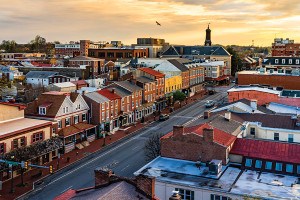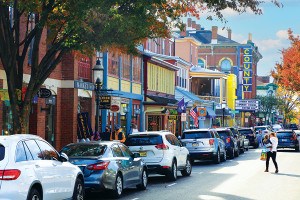The Amazing History of the People’s Trust Co. at 12th and Arch, Once Home to the Fabric Workshop
Now here’s a building from when they knew how to build buildings. The People’s Trust Company Building ruled the corner of 12th and Arch for eight decades. Its unusual design and construction made it a marvel in its own time…but that crap didn’t matter when the Pennsylvania Convention Center came along to knock it out of existence.
The short-lived People’s Trust Company of Philadelphia was chartered on September 21, 1906, and started out in a small office at 1006 Arch Street. Almost immediately, this new financial institution, just a branch of a nationwide series of People’s Trust Companies, put together plans to build a speculative 10-story high-rise only a block away. This neighborhood was going through an extremely rapid change at the time.
In the mid-19th century, the area was one of the most desirable residential neighborhoods in the city. However, when City Hall and the Reading Terminal were built nearby, commerce and industry barreled through and wiped its quaint residential nature off the map. The newly formed People’s Trust jumped on the construction bandwagon in a big way. They wanted their new headquarters to tower over everything else in the immediate area and be a landmark of building design and technological innovation. How? The new high-rise would be built of concrete!
That’s right, concrete. The same material used for the ugly-ass mid-century modern piece-of-trash architecture of the ’50s and ’60s was also used to create this beautiful high-rise from the height of architectural exuberance. At the time, all anyone cared about when building a high-rise was fire suppression. It was claimed that a steel-reinforced concrete building skeleton would be able to withstand 3,000 degrees for a period of up to six hours. Therefore, this new technology wasn’t just there for coolness points, it was there to save lives.
People’s Trust then went even further–not only would this beast be built of concrete, it would also work with a different purpose than other high-rises in the city. The first floor and mezzanine of the building would be dedicated to finance, but the rest of the building would support manufacturing. Essentially, the People’s Trust Company Building would be an industrial, not commercial, high-rise.
In order to properly execute this, the company had to hire a Marvel Team-Up of different architects. They commissioned the brand-new architecture firm Sauer & Hahn for the initial design, then got support from veteran industrial architect Charles Balderston to add the manufacturing elements. On top of that, since the building was to be built of concrete, they brought in concrete engineer William H. Cravell to figure out how the hell they would get it built.
Work on the project began in late 1908. By mid-1909, the largest concrete foundation ever poured (up to that point) was completed and the concrete skeleton, made from 75,600 cubic feet of concrete and 476,294 pounds of reinforcing steel, was on its way up.
 The concrete skeleton. Source: Concrete Age, Volume 11 |
Though the 150-foot-tall building was billed as being completely supported by concrete, it was a lie. The interior columns on the first six floors were steel covered in the thin layer of concrete. This was the only way to keep the columns thin enough to make the space on those floors desirable to use. Unlike its mid-century modern counterparts, the concrete frame of the structure was completely hidden on the outside. A facade of beautifully ornamented terra cotta covered the entire tower.
The new building finally opened in the summer of 1910, though the People’s Trust Company had already moved into the first floor in late 1909. The Union Special Machine Company, a massive sewing machine concern with factories all over the country, was among the first to use the upper manufacturing floors.
Once they moved, the People’s Trust Company decided to grow even more. Only four years after moving in, they started the People’s Bank of Philadelphia. This, of course, is not to be confused with the People’s Savings Bank of Philadelphia, the first African-American owned and run bank in the city, or the first People’s Bank of Philadelphia, which folded in 1898 due to massive corruption.
Nonetheless, it seems that the People’s Trust expanded too quickly. By 1923, they were forced to merge their two interests into the People’s Bank and Trust Company, which merged itself out of existence by 1927. The building they created would serve as the People’s Trusts’ only real legacy.
Around the time this building was built, the devolution of the neighborhood was already in full swing. The rapid elimination of the residential neighborhood created a haven of debauchery and iniquity. Burlesque Houses and dens of prostitution started to litter the area. Row-mansions leftover from the neighborhood’s Golden Age were now being used as seedy rooming houses. The location became part of the city’s infamous “Furnished-Room District” and was already the subject of detailed sociological investigations by 1912. The unfortunate nature of this neighborhood would go on to last all the way into the early 21st century, well after this building and its cohorts were eliminated.
The crappiness of the neighborhood led the rent for space in the People’s Trust Building to become dirt-cheap. By the start of the 1930s, some of the manufacturing floors were converted to super-discounted office space. The next few decades would see numerous companies come and go while the surrounding area got dingier and dingier. The Belmont Packing and Rubber Company in the 30s, Gamson Coats and Suits in the ’40s, Jaffe Bros Inc (printers) in the ’50s, EMC Technology and Electro-Science Labs in the ’60s, Clover Cravat, a necktie manufacturer, in the early 1970s.
In 1977, the People’s Trust Company Building became the first home of the Fabric Workshop, which in their own words enables “the finest artists today to work with new materials and new media, to expand the frontiers of contemporary artistic practice, and to educate the public about the significance of contemporary art.” They stuck around in this building until its demolition and are still around as the Fabric Workshop and Museum down the street. The Lema Novelty Company was among the last businesses to use the structure before moving to Glenside, PA.
Once it was determined that the new Pennsylvania Convention Center would be rocking its way through the old Furnished Room District, the People’s Trust Company Building’s days were numbered. Buildings surrounding the tower started going down in 1987 and the People’s Trust was gone by 1989. Ironically, the firm that did the archeological dig in the neighborhood before the convention center went up, John Milner Associates, had an office in the People’s Trust Company Building in 1938.
Now that the Pennsylvania Convention Center is turning out to be a big bust (thanks again, Carpenter’s Union), it seems even more shameful that we lost this and the buttload of other awesome buildings that once imbued the neighborhood with architectural awesomeness. I’d rather have a red light district full of sin and debauchery than the useless three-block-long bastard that sits there now. Thanks a lot, a-holes.





